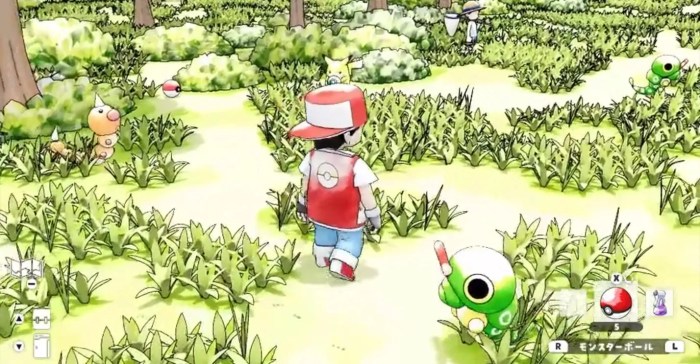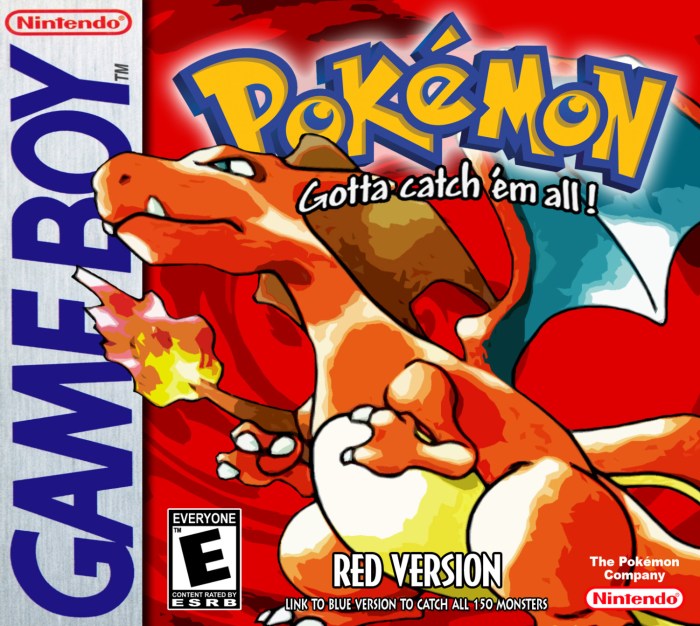Pokemon red original game – Embark on an epic journey with Pokémon Red Original Game, the trailblazing title that introduced the world to the beloved Pokémon franchise. As the pioneer of the series, this game laid the foundation for countless hours of adventure, capturing the hearts of gamers worldwide.
Set in the vibrant Kanto region, players take on the role of a young Pokémon Trainer embarking on a quest to become a Pokémon Master. Along the way, they encounter a diverse cast of characters, engage in thrilling battles, and unravel a captivating storyline that has captivated generations.
Game Overview

Pokémon Red is a role-playing game developed by Game Freak and published by Nintendo for the Game Boy. It was first released in Japan in 1996 and later in North America and Europe in 1998. The game is set in the fictional Kanto region, where players take on the role of a young Pokémon Trainer who embarks on a journey to become the Pokémon League Champion.
The game’s core gameplay mechanics involve exploring the game world, capturing and training Pokémon, and battling against other Trainers and Gym Leaders. Players can capture Pokémon by weakening them in battle and then throwing a Poké Ball at them. Once captured, Pokémon can be trained by battling them against other Pokémon or using items to increase their stats.
Players can also evolve their Pokémon by leveling them up or using special items.
Characters and Creatures
Main Characters
The main character of Pokémon Red is a young boy named Red. He lives in the town of Pallet Town and dreams of becoming the Pokémon League Champion. Red is joined on his journey by his rival, Blue, who is also a Pokémon Trainer.
Other important characters in the game include Professor Oak, who gives Red his first Pokémon, and Misty, the Gym Leader of Cerulean City.
Pokémon, Pokemon red original game
There are 151 different species of Pokémon in Pokémon Red. Pokémon are classified into different types, each with its own strengths and weaknesses. The different types of Pokémon include Normal, Fire, Water, Grass, Electric, Ice, Fighting, Poison, Ground, Flying, Psychic, Bug, Rock, Ghost, and Dragon.
Exploration and Adventure
Areas
The Kanto region is divided into several different areas, each with its own unique environment and challenges. Players can explore forests, mountains, caves, and oceans, and they can visit towns and cities to rest and stock up on supplies.
Challenges
Players will face a variety of challenges during their journey, including wild Pokémon battles, Gym Leader battles, and puzzles. Wild Pokémon battles can be used to capture new Pokémon or to train existing Pokémon. Gym Leader battles are more difficult than wild Pokémon battles, and players must defeat the Gym Leader in order to earn a Gym Badge.
Puzzles can be found throughout the game world, and they can be used to access new areas or to obtain items.
Rewards

Players who complete challenges will be rewarded with experience points, money, and items. Experience points can be used to level up Pokémon, money can be used to purchase items, and items can be used to heal Pokémon or to increase their stats.
Battles and Combat: Pokemon Red Original Game
Battle System
Pokémon Red uses a turn-based battle system. In a turn-based battle, each Pokémon takes turns attacking the other Pokémon. The Pokémon that attacks first is determined by its Speed stat. Each Pokémon has a set of moves that it can use in battle.
Moves can be used to attack the opponent, to heal the user, or to change the status of the opponent.
Types of Attacks
There are several different types of attacks in Pokémon Red, including Normal, Fire, Water, Grass, Electric, Ice, Fighting, Poison, Ground, Flying, Psychic, Bug, Rock, Ghost, and Dragon. Each type of attack is effective against certain types of Pokémon and not effective against others.
Strategies and Tactics

Winning battles in Pokémon Red requires using the right strategies and tactics. Players must choose the right Pokémon to use in battle, and they must use the right moves at the right time. Players must also be aware of the strengths and weaknesses of their own Pokémon and the opponent’s Pokémon.
Graphics and Sound
Pixel Art Style
Pokémon Red uses a pixel art style for its graphics. The characters and environments are made up of small, square pixels. The pixel art style gives the game a charming and retro look.
Music and Sound Effects
The music and sound effects in Pokémon Red are simple but effective. The music is catchy and memorable, and the sound effects help to create a sense of atmosphere. The technical limitations of the Game Boy mean that the music and sound effects are not as sophisticated as they are in later Pokémon games, but they still add to the game’s overall charm.
Cultural Impact
Popular Culture
Pokémon Red has had a major impact on popular culture. The game has been praised for its innovative gameplay, its charming characters, and its addictive nature. Pokémon Red has been credited with helping to popularize the role-playing game genre and with creating a new generation of Pokémon fans.
Legacy
Pokémon Red is considered to be one of the most important video games of all time. The game has sold over 31 million copies worldwide, and it has been ported to several different platforms. Pokémon Red has spawned a number of sequels and spin-offs, and it has helped to create a multi-billion dollar franchise.
Fan Base and Community
Pokémon Red has a large and dedicated fan base. Fans of the game have created a number of websites, forums, and communities dedicated to discussing the game and sharing their experiences. The Pokémon fan base is one of the most active and passionate in the world.
Questions and Answers
What is the objective of Pokémon Red Original Game?
The goal is to become a Pokémon Master by completing the Pokédex, defeating eight Gym Leaders, and ultimately challenging the Elite Four and the Champion.
How many Pokémon are there in Pokémon Red Original Game?
There are 151 Pokémon in the original game.
What are the different types of Pokémon?
Pokémon come in 18 different types, each with its own strengths and weaknesses.
